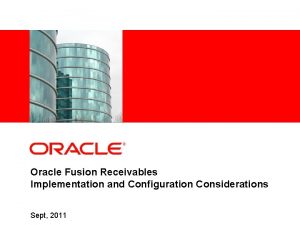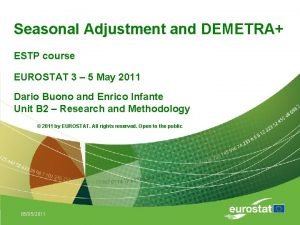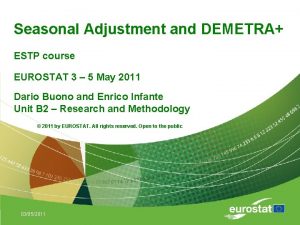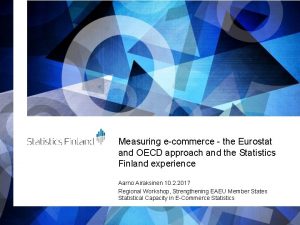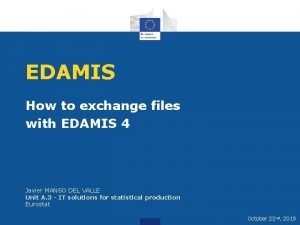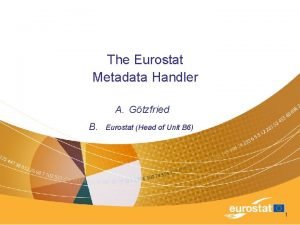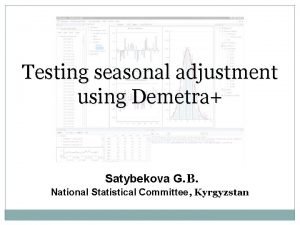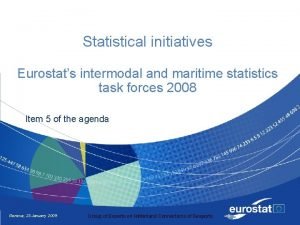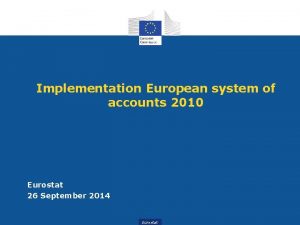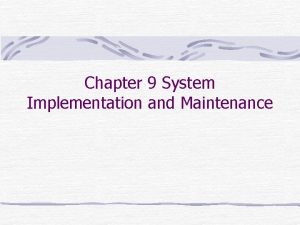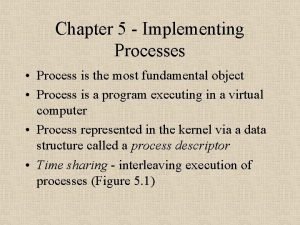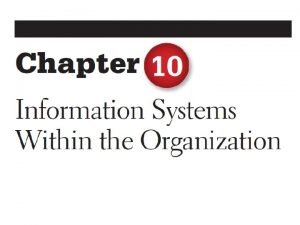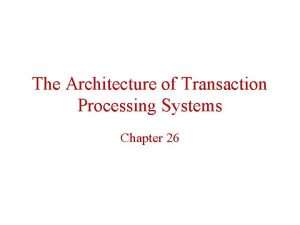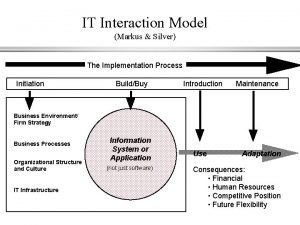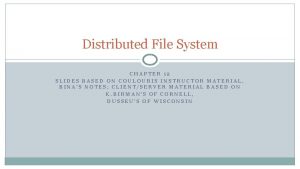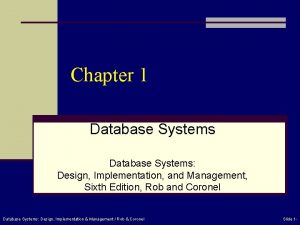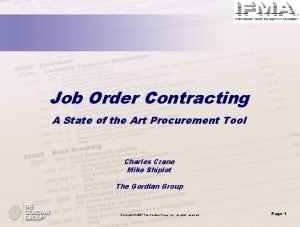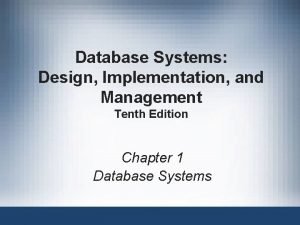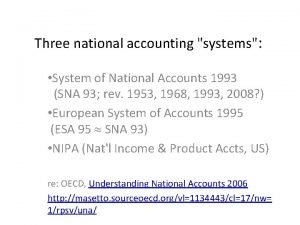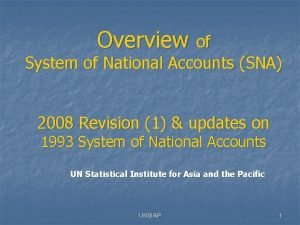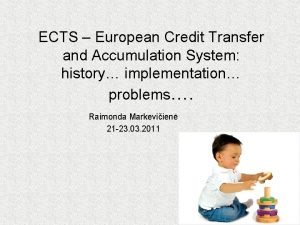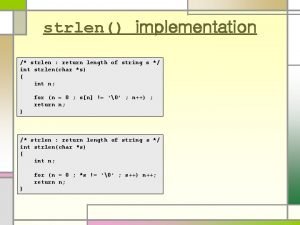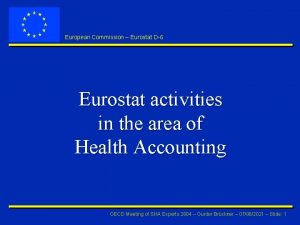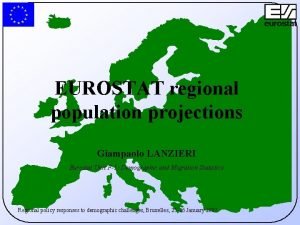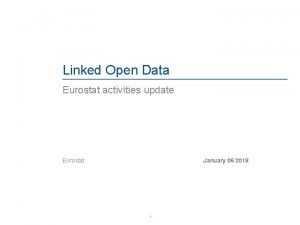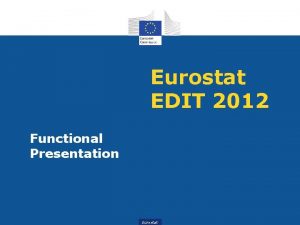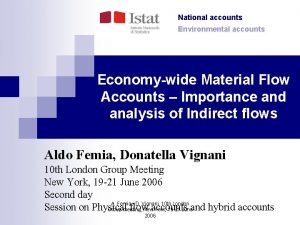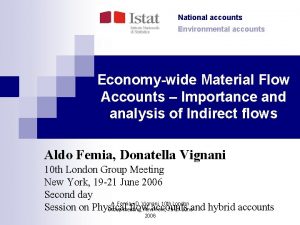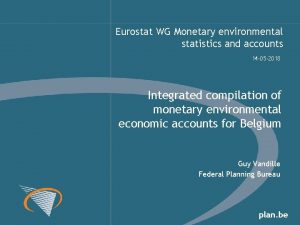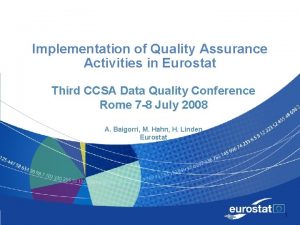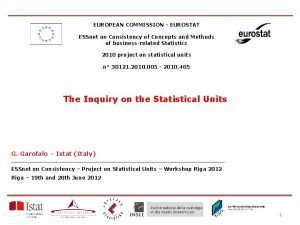Implementation European system of accounts 2010 Eurostat 26


















































- Slides: 50

Implementation European system of accounts 2010 Eurostat 26 September 2014 Eurostat

Introduction • • Welcome Overview of the presentations No data yet Questions after the presentation Eurostat

Content overview • Part A: General aspects regarding the implementation of ESA 2010 methodology • Part B: Impact of ESA 2010 on the statistics for the excessive deficit procedure • Part C: Disseminating the main national accounts aggregates in ESA 2010 • References Eurostat

A. General aspects regarding the implementation of ESA 2010 methodology Overview of topics 1. Why a new system of accounts 2. Specific role of ESA in the European Union 3. Main improvements 4. Capitalisation of research and development 5. Some other changes Eurostat

A. General aspects regarding the implementation of ESA 2010 methodology Overview of topics (continued) 6. Extended dissemination programme 7. Implementation issues 8. Blue books, manuals and training 9. Communication Eurostat

A 1. Why a new system of accounts • New SNA (after SNA 1993) • New ESA 2010 (after ESA 1995) • Update, no revolution • Reflects evolving needs of users and changed economic environment Eurostat

A 2. Specific role of ESA in the European Union • Regulation • EU budget • Fiscal policy: ratios of deficit and debt • Structural funds: regional GDP • Macroeconomic Imbalance Procedure (MIP) Eurostat

A 3. Main improvements • ESA 1995 -> ESA 2010: 44 improvements • Capitalisation of research & development • Capitalisation of military 'weapon systems' • Change in treatment of imports/exports of 'goods sent abroad for processing' • Supplementary information on pension entitlements • Better measure of output of non-life insurance • Revised and extended dissemination programme Eurostat

A 4. Capitalisation of research and development (1) • In a modern and digitalised economy, investment in R&D is an essential driver for growth • ESA 1995: R&D expenditures were 'consumed' in the period • ESA 2010 'capitalises' these expenditures • Bold change, compared to standard business accounting • Good sources • Stronger analytical capacity of balance sheets Eurostat

A 4. Capitalisation of research and development (2) • ESA 1995 underestimated: ü Stock of assets ü GDP ü Operating surplus • Under ESA 2010: ü GDP increases ü Diversity between Member States ü Ratios expressed in terms of GDP will slightly decrease Eurostat

A 5. Some other changes • Capitalisation of weapon systems • Goods sent abroad for processing ü ü Strict change of ownership Processing services No impact on overall current account Nor on GDP • Pension schemes ü Supplementary table for international comparability Eurostat

A 6. Extended dissemination programm (1) • More complete balance sheet data • Enlarged set of assets types for capital formation • More detailed breakdowns of financial accounts • New set of data on potential obligations of government Eurostat

A 6. Extended dissemination programm (2) • Supplementary table on pension schemes • Improved timeliness, more quarterly variables, seasonally adjusted • More data focussing on the household sector Eurostat

A 7. Implementation issues • • Blue books Methodological manuals Training SDMX Eurostat

A 8. (1) Blue books • ESA 2010 • Transmission programme Eurostat

A 8. (2) Manuals • Changes ESA 1995 – ESA 2010 • Measuring R&D • Goods sent abroad for processing • Regional accounts • Compilation guide on pension data • Government deficit and debt Eurostat

A 8. (3) Training • In 2012 -2014 several trainings were organised • Internal and external teachers • In 2014 some remaining trainings planned Eurostat

A 8. (4) SDMX • ESA 2010 data transmission based on SDMX -ML • Extensive testing • Training/meetings/webinars Eurostat

A 9. Communication (1) • Dedicated section on the Eurostat website Eurostat

A 9. Communication (2) • Press briefings in January and October 2014 Eurostat

A 9. Communication (3) • 12 -13 June 2014 Conference 'The accounts of society' Eurostat

A 9. Communication (4) • New Eurostat review on national accounts • Next issue on implementation of ESA 2010 Eurostat

A 9. Communication (5) • Videos • Youtube/website Eurostat

B: Impact of ESA 2010 on the statistics for the excessive deficit procedure Overview of topics 1. Background: EDP and national accounts 2. What is new in ESA 2010 for EDP statistics? 3. Government sector and public sector Eurostat

B: Impact of ESA 2010 on the statistics for the excessive deficit procedure Overview of topics (continued) 4. The crucial distinction between market and non -market units 5. Sector classification of non-profit institutions 6. Sector classification of specific bodies set up by government Eurostat

B 1. Background: EDP and national accounts • Overview on EDP • National accounts as reference statistical framework • Consequences in practice • Role of Eurostat • Over 2 'EDP decades': 3 successive National Accounts Systems: ESA 79 up to 2000, ESA 95 up to Sep 2014 (very important changes: 'accrual', balance sheets, other flows) and now ESA 2010 Eurostat

B 2. What is new in ESA 2010 for EDP statistics? (1) • A dedicated chapter 20: 'the government accounts' (similar to chapter 22 in SNA 2008) • Why such a chapter • Four sections 1) Defining the general sector 2) Describing a 'government finance presentation of statistics' (for the total general government sector and each of the sub-sectors), in addition to the NA sequence of accounts, based on revenue/expenditure Eurostat

B 2. What is new in ESA 2010 for EDP statistics? (2) • Four sections (continued) 3) Addressing accounting issues relating to government. Not new as regards EDP statistics because most provisions already developed in the Manual on government deficit and debt (MGDD) of Eurostat from 1999 onwards, such as: ü ü ü Capital injections Super-dividends Guaranties Debt operations Public-Private-Partnerships Time of recording taxes Eurostat

B 2. What is new in ESA 2010 for EDP statistics? (3) • Four sections (continued) 4) Introducing the notion of public sector (not in ESA 95) • Some changes with an indirect impact on EDP statistics through the increase in GDP (change in EDP ratios) Eurostat

B 2. What is new in ESA 2010 for EDP statistics? (4) • One significant example: 'capitalisation' of research & development • Another example, more specific to government: military equipment (now considered as fixed capital) but no change on the government deficit/surplus and the EDP ratios Eurostat

B 2. What is new in ESA 2010 for EDP statistics? (5) • Other changes relating to government activity: ü ü ü ü ü Delimitation of the general government sector Interest under swaps Payable tax credits VAT-based third resource Use of natural resources Transfer of pension obligations Standardised guarantees Supplementary information on pension obligations (And various other rather minor changes) Eurostat

B 3. Government sector and public sector (1) • Public sector = general government sector + public (financial/non-financial) corporations, i. e. controlled by government unit(s) • Control defined as the ability to determine the general policy, the strategy, the programme of a unit Eurostat

B 3. Government sector and public sector (2) • Some criteria straightforward (ownership, voting rights, appointments) • In some cases, control also assessed by other criteria • Control of high interest for EDP purposes because of some 'special' transactions with government and of potential risks Eurostat

B 4. The crucial distinction between market and non-market units (1) • 'Market' if output sold at 'economically significant prices' (as 'signals' influencing economic behaviour) • Government by essence non-market (main tasks: providing services for the community and redistributing income and wealth) but possible residual (incidental) market activity (e. g. museum shops, sales of publications…) • A public market unit, 'never' in GG sector • A public non-market unit, 'always' included in the GG sector Eurostat

B 4. The crucial distinction between market and non market units (2) • Preliminary step: special features in the activity of the unit, in link with government? ü Ancillary unit? ü Output sold only to government or less than 50%? • If not the case, quantitative test: ü If the ratio sales/costs at least equal to 50%, public unit considered as market producers, classified outside the government sector Eurostat

B 5. Sector classification of non-profit institutions • What? • From 'controlled and financed' in ESA 95 to 'controlled' in ESA 2010 • In ESA 20 a set of criteria, of which the 'degree of financing' but financing as such not sufficient if no influence on the general policy of the NPI • Government control = classification of the NPI in the general government sector • Typical examples: schools and hospitals Eurostat

B. 6 The sector classification of specific bodies set up by government (1) • As a general rule, for financial corporations, quantitative test not relevant (except some financial auxiliaries) • Relevant question: acting as financial intermediaries? • Specific case of 'public financial defeasance structures' • Public Holding Companies and Head Offices • Pensions funds Eurostat

B 6. The sector classification of specific bodies set up by government (2) • • • Privatisation and restructuring agencies Special purpose entities Joint ventures Market regulatory agencies Sovereign funds (and other reserve funds) European bodies linked to the euro area sovereign debt crisis (EFSF/ESM) Eurostat

C. Disseminating the main national accounts aggregates in ESA 2010 Overview of topics 1. Introduction 2. ESA 2010 in Eurobase 3. Main changes from ESA 95 to ESA 2010 in Eurobase Eurostat

C 1. Introduction (1) • Receiving the data + + Eurostat ESA 2010 Questionniares

C 1. Introduction (2) • ESA 2010 Transmission Programme Table 1: Main aggregates – Q & A Table 3: Tables by industry Table 5: Household final consumption expenditure Table 20: Cross classification of fixed assets by industry and by asset (stocks) Table 22: Cross classification of gross fixed capital formation (GFCF) by industry and by asset (transactions) Table 26: Balance sheets for non-financial assets Eurostat

C 1. Introduction (3) Eurostat

C. 2 ESA 2010 in Eurobase (1) Eurostat

C. 2 ESA 2010 in Eurobase (2) • National Accounts Main aggregates Annual nama_10 • National Accounts Main aggregates Quarterly namq_10 Eurostat

C. 2 ESA 2010 in Eurobase (3) Main GDP aggregates Auxilliary data Basic breakdowns (industry & asset) GDP & main components Population & employment Gross Value added and income (A*10) Main GDP aggregates per capita Gross fixed capital formation (AN_F 6) Labour productivity and unit labour costs Employment (A*10) Final consumption aggregates by durability Exports and imports by MS Eurostat

C. 2 ESA 2010 in Eurobase (4) Breakdowns of nonfinancial assets by type, industry and sector Main GDP aggregates – Detailed breakdowns Main aggregates A*21 Fixed assets (stocks) Gross capital formation A*38 Fixed assets (flows) AN_F 6 Employment A*64 Balance sheets Household expenditure COICOP Eurostat

C. 3 Main changes from ESA 95 to ESA 2010 in Eurobase (1) 1. Datasets: (87) Data set Data set Data set (25) NACE Rev 2 2. NACE Rev 1. 1 Eurostat

C. 3 Main changes from ESA 95 to ESA 2010 in Eurobase (2) 3. Focused on item to be analysed Unit measure Current prices Volumes Price Indices 4. Primary income series Primary Income series (PI) Sector accounts Eurostat PI data

References For further information • Eurostat website: http: //epp. eurostat. ec. europa. eu/portal/page/po rtal/esa_2010/introduction • Eurostat data base: http: //epp. eurostat. ec. europa. eu/portal/page/po rtal/statistics/search_database Eurostat

Implementation European system of accounts 2010 Eurostat 26 September 2014 Eurostat
 Lockbox oracle fusion
Lockbox oracle fusion Structural business statistics eurostat
Structural business statistics eurostat Eurostat query builder
Eurostat query builder Demetra eurostat
Demetra eurostat Skippedlag
Skippedlag Oecd e-commerce statistics
Oecd e-commerce statistics Eurostat datubāze
Eurostat datubāze Edamis4
Edamis4 European health interview survey (ehis)
European health interview survey (ehis) Eurostat group
Eurostat group Ess metadata handler
Ess metadata handler Demetra eurostat
Demetra eurostat Eurostat maritime transport statistics
Eurostat maritime transport statistics Eurobase eurostat
Eurobase eurostat System implementation and maintenance
System implementation and maintenance Implementation of process in operating system
Implementation of process in operating system System implementation and operation
System implementation and operation A transaction is any business event that generates
A transaction is any business event that generates Rpc implementation in distributed system
Rpc implementation in distributed system What is system construction
What is system construction 8 phases of sdlc
8 phases of sdlc Cse 132
Cse 132 Rpc implementation in distributed system
Rpc implementation in distributed system It interaction model
It interaction model Distributed file system notes
Distributed file system notes Database system design implementation and management
Database system design implementation and management A model that is the demo implementation of the system.
A model that is the demo implementation of the system. Job order contracting (joc) system implementation
Job order contracting (joc) system implementation Database systems design implementation and management
Database systems design implementation and management What is system of national accounts
What is system of national accounts Sna 2008
Sna 2008 Reconciling control accounts
Reconciling control accounts Nspa infohub
Nspa infohub Feudal pyramid
Feudal pyramid European plate observing system
European plate observing system European statistical system committee
European statistical system committee European collateral management system
European collateral management system European manorial system
European manorial system European credit transfer and accumulation system
European credit transfer and accumulation system Collateral and liquidity management
Collateral and liquidity management Closed system earth
Closed system earth Digestive respiratory and circulatory system
Digestive respiratory and circulatory system Strlen implementation
Strlen implementation Organizing for action strategy implementation
Organizing for action strategy implementation Strategy implementation
Strategy implementation Strategic implementation plan
Strategic implementation plan Siem rfp template
Siem rfp template Sdtm ig
Sdtm ig Swot analysis for school improvement plan
Swot analysis for school improvement plan Sas kpmg
Sas kpmg Ra 10912 is applicable only for accreditation renewal
Ra 10912 is applicable only for accreditation renewal
